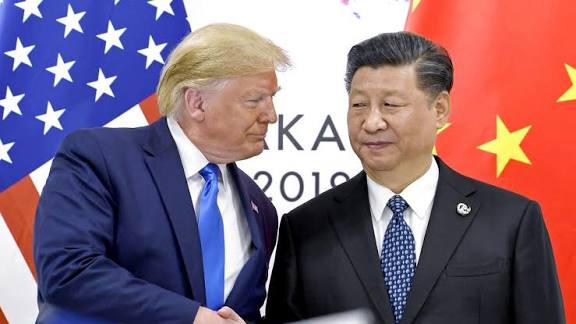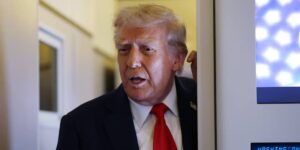BREAKING: Trump & Xi Approve TikTok Deal After Tense Phone Call

Trump wrote on Truth Social that the call was “productive” and he appreciated “approval of the deal of Axi”. Today we will discuss about BREAKING: Trump & Xi Approve TikTok Deal After Tense Phone Call
BREAKING: Trump & Xi Approve TikTok Deal After Tense Phone Call
In a development with major implications for U.S.-China relations, digital policy, and national security, President Donald Trump announced that Chinese President Xi Jinping has approved a deal to restructure TikTok’s operations in the United States. The announcement came after what Trump described as a “very productive” phone call between the two leaders. While many details are still unclear, key points—ownership changes, algorithm control, board oversight, and data security—are now emerging. This move could avert a U.S. ban on the platform, one of the most contentious tech policy collisions in recent years.
What We Know So Far

-
Trump’s Statement: President Trump said Xi Jinping has approved a TikTok deal, and that the deal is “well on its way.”
-
Framework has been in place: U.S. negotiations and frameworks had been under discussion, especially after Congress passed a law in 2024 mandating divestment or a ban of TikTok’s China-based parent company ByteDance.
-
Phone Call and Diplomacy: The call between Trump and Xi lasted about two hours. They agreed to meet in person at the APEC Summit in South Korea at the end of October, and Trump said he would visit China early next year.
-
Chinese Response: Beijing, while noting support for “productive commercial negotiations,” has been more circumspect in its public statements. China emphasized non-discrimination, market principles, and legal compliance but has not formally confirmed all terms.
Key Terms Under Discussion
Several core aspects of the deal are either agreed in principle or under negotiation. These include:
-
Ownership Structure:
The plan would see a newly formed U.S. entity take control of TikTok’s U.S. operations. ByteDance, the Chinese parent company, would retain less than 20% ownership. The majority of ownership would lie with American investors. -
Board Oversight:
Under the emerging deal, Americans will occupy six of the seven seats on the U.S. board overseeing TikTok operations. The one remaining seat would be designated by ByteDance. This is meant to ensure that Americans have operational control, particularly with regard to decision-making and algorithm oversight. -
Algorithm Control & Content Recommendation System:
One of the biggest sticking points has been who controls the algorithm that determines what content is shown to U.S. users. According to U.S. sources, the algorithm will be overseen by U.S. authorities and retrained or operated in the U.S. independently of ByteDance. However, there are indications that some licensing arrangement or components of the Chinese-origin algorithm may still play a role. -
Data Security & U.S. Infrastructure:
The U.S. side wants all U.S. user data stored on cloud infrastructure controlled by or accessible to U.S. companies (notably Oracle). This is to reduce or eliminate risk of Chinese government access or influence.
Legal & Legislative Background
To understand how this deal came about, one needs to know the legal pressures and legislative actions that forced the issue:
-
Protecting Americans from Foreign Adversary Controlled Applications Act (PAFACA):
Passed by U.S. Congress in April 2024, this law required apps controlled by foreign adversaries (which explicitly included ByteDance/TikTok) to divest or face a complete ban. The law’s enforcement deadline was January 19, 2025. -
Supreme Court Ruling:
TikTok challenged the law, arguing constitutional concerns (free speech, etc.), but the Supreme Court upheld the law in a unanimous decision. This left the U.S. government with strong legal leverage to force changes unless ByteDance complied. -
Executive Orders & Extensions:
Enforcement of the law was delayed multiple times by executive orders by President Trump after taking office. The deadline was pushed back, giving ongoing negotiations time.
Why It’s Significant
The agreement (or framework) carries implications on multiple fronts:
-
For U.S. National Security:
U.S. officials have long argued that TikTok’s access to massive amounts of personal user data, combined with its China-based ownership, could create risks—ranging from data extraction to influence operations via content recommendation algorithms. The deal attempts to mitigate those risks. -
Precedent for Tech & Trade Policy:
This could set the standard for how the U.S. handles similar cases where national security, foreign investment, or foreign ownership of digital infrastructure are concerned. It also reflects how trade policy, tech regulation, and national security are now tightly intertwined. -
Impact on TikTok Users & Creators:
For millions of users in the U.S., the worry of the app being banned may be over (for now). For content creators and businesses using TikTok, clarity of regulation, ownership, and operation could mean more stability—or more regulation. -
Political Implications:
This is a win, or could be spun as a win, for the Trump administration: fulfilling a campaign promise to take a hard line on China while avoiding a full-blown ban. Domestically, it may help neutralize criticism from both sides: from those who fear China’s influence and from those who worry about censorship or overreach.
Areas of Uncertainty & Contention
Though Trump says the deal has been “approved,” there remain several open questions and possible points of friction:
-
China’s Real & Formal Approval:
While Trump states Xi has approved the deal, Chinese responses have been less explicit. No full official Chinese statement confirming the detailed terms has been released. There’s concern that China may allow the optics of approval but reserve rights or delay on key elements. -
Algorithm Licensing vs Control:
Even if the U.S. controls the algorithm governing content for U.S. users, whether components of the Chinese algorithm or intellectual property remain linked to Beijing is disputed. Some reports suggest licensing rather than full separation in some respects. That may pose risks or be seen as insufficient by critics. -
Congressional Oversight & Approval:
With the legislative law already mandating divestment, Congress is likely to scrutinize the deal. Any structure that appears to allow substantial influence from ByteDance or China may trigger resistance, legal challenges, or additional mandates. -
Timing & Final Signatures:
The deal still needs formal signing or finalization, and that may include further negotiations, especially over technical details (algorithm, data storage, etc.). The agreed face-to-face meetings at APEC and possible U.S./China visits will likely be part of that process.
Potential Scenarios Going Forward
Given the current status, several outcomes are possible:
| Scenario | Description | Implications |
|---|---|---|
| Full divestment + U.S. control | ByteDance sells its controlling or majority interest, with U.S. investors owning ~80%+, full U.S. oversight of algorithm, U.S. data storage and security. | Most national security concerns addressed; TikTok safely continues; U.S. precedent for handling foreign-controlled tech. |
| Partial control & licensing | ByteDance keeps a minority stake; U.S. regulators have oversight; algorithm licensed or partially shared; data stored in the U.S.; China retains some indirect influence. | Might satisfy some parties; could still face criticism as incomplete; risk of loopholes or future disputes. |
| Delay or derailment | Negotiations falter, China resists some terms, or legislative/technical hurdles block components; could lead back to threats of ban. | Could damage U.S. credibility; hurt investors and creators; escalate into harsher restrictions. |
| Hybrid arrangement | A mix – e.g. U.S. board control, U.S. data infrastructure, but some dependency or contract/licensing with ByteDance on algorithm or tech. | Compromise; may draw criticism from both sides; defines new model for cross-border tech control. |
Broader Implications
-
For U.S.–China Relations:
This deal may serve as a confidence-building measure following years of trade wars, tensions over technology, intellectual property, and geopolitical rivalry. If both sides hold to the deal, it could open paths for cooperation in other contested areas. If not, it may deepen distrust. -
For Tech & Regulatory Policy Worldwide:
Other countries watching closely may adopt similar frameworks—for example, requiring foreign-owned platforms to restructure ownership, ensure data localization, and define algorithmic responsibility. This could accelerate a trend towards “splinternet” or more segmented internet governance. -
For Companies & Investors:
American investors involved in TikTok’s new U.S. entity stand to gain massively if the platform continues to grow. For ByteDance, even with reduced stake, maintaining involvement (or licensing) could retain value—but only if legal and regulatory exposure is manageable. -
For Users & Civil Liberties:
Ensuring content moderation, free expression, privacy will likely be part of the negotiations and oversight. There’s a balancing act: controlling foreign adversary influence without censoring speech or undermining user trust. How that balance is handled will affect public perception and legal challenges.
What Critics Are Saying
-
Risk of China’s hidden influence:
Skeptics warn that even minority ownership, algorithm licensing, or IP sharing could allow indirect control or backdoors. They ask whether U.S. oversight can truly guard against influence operations or data access by Beijing. -
Free Speech Concerns:
Some civil liberties advocates worry that increased government involvement in oversight or algorithm control could lead to censorship or manipulation of content. They argue transparency and subject to law are necessary. -
Effectiveness of Regulation:
Some technical experts question whether algorithm retraining or oversight can fully sever influence, given that algorithms are composed of many parts, including training data, model architecture, updates, etc. Some components might still be developed abroad, and secrets on how recommendation systems work are tightly held. -
Economic & Business Risks:
Investors may worry that regulatory uncertainty will persist, legal challenges (in U.S. or China) might increase, or public trust in TikTok could be affected during the transition. For ByteDance, loss of control threatens profitability; for U.S. investors, compliance costs could be high.
Keyword-Rich Context: Why “TikTok Deal”, “Trump & Xi”, “Algorithm Control”, “Ownership Restructure”, “U.S. Ban”, “ByteDance Divestment” Matter
For readers and search engines alike, several terms are central:
-
TikTok Deal
-
Trump & Xi Approve
-
Ownership Restructure / ByteDance Divestment
-
Algorithm Control & Oversight
-
National Security / Data Security
-
U.S. Ban / Legislation (PAFACA)
These are not just buzzwords—they correspond to the legal, operational, and geopolitical levers driving the story.
Timeline of Key Events
-
April 2024: U.S. Congress passes PAFACA, requiring divestment or ban of TikTok/ByteDance.
-
January 2025: Deadline for compliance; enforcement delayed; Supreme Court upholds the law.
-
Through 2025: Negotiations, extensions, executive actions continue; discussions in trade contexts (Madrid, etc.).
-
September 19, 2025: Trump says Xi has approved the deal; phone call described as “very productive”.
-
End of October 2025: Agreed meeting at APEC Summit in South Korea for further negotiation and perhaps formal sign-off.
What to Watch Next
-
Official Documents & Sign-offs:
Leaks or releases of the actual deal terms. Look for the final ownership percentages, control over algorithm, board membership, and data rules. -
Congressional Hearings or Approval:
Whether Congress accepts the arrangement, seeks changes, or challenges it in court. -
Chinese Official Reaction:
Speeches, White Paper(s), or legal statements from Beijing on whether the deal meets its own laws and expectations, especially in terms of technology export, IP, and algorithm licensing. -
Implementation Challenges:
How quickly will the new ownership structure be put in place? How will data be transferred or stored? How will algorithm oversight and retraining be handled technically and legally? -
Public & User Sentiment:
Will users trust TikTok post-deal? Will creators adapt to any changed rules or oversight? How will competitors respond?
Conclusion
The reported approval by President Xi of a TikTok deal following his call with President Trump is a watershed moment in the intersection of tech policy, national security law, and international diplomacy. If fully realised, it may represent a model for how the U.S. deals with foreign-owned platforms that hold vast amounts of user data. The deal navigates a tricky balance: securing U.S. interests while permitting continued operation of a platform beloved by many.
However, as of now, many details remain to be confirmed publicly: algorithm control, the exact ownership structure, China’s formal commitments, oversight mechanisms, and how the deal will satisfy Congress and legal mandates. The next few weeks and months—through APEC, regulatory filings, and public disclosures—will be critical.
For now, the narrative shifts from a looming ban to complex negotiations, with both sides appearing to have made soft concessions. Whether this leads to durable resolution or merely postpones confrontation remains to be seen.
How useful was this post?
Click on a star to rate it!
Average rating 0 / 5. Vote count: 0
No votes so far! Be the first to rate this post.
About the Author
usa5911.com
Administrator
Hi, I’m Gurdeep Singh, a professional content writer from India with over 3 years of experience in the field. I specialize in covering U.S. politics, delivering timely and engaging content tailored specifically for an American audience. Along with my dedicated team, we track and report on all the latest political trends, news, and in-depth analysis shaping the United States today. Our goal is to provide clear, factual, and compelling content that keeps readers informed and engaged with the ever-changing political landscape.




